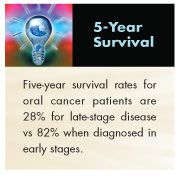Chemiluminescence Plus Blue Stain Flags Oral Cancer
Combining chemiluminescent examination with toluidine blue staining greatly improves the accuracy of visual screening for oral cancer and could reduce the number of noninformative biopsies
RANCHO MIRAGE, California-Combining chemiluminescent examination with toluidine blue staining greatly improves the accuracy of visual screening for oral cancer and could reduce the number of noninformative biopsies, Joel B. Epstein, DMD, of the University of Illinois at Chicago, College of Dentistry, reported at the 2007 Multidisciplinary Head & Neck Cancer Symposium (abstract 12). Dr. Epstein and his colleagues tested the visualization techniques in an attempt to improve current outcomes based on conventional visual examination of oral mucosal lesions. About two-thirds of oral cancer patients have late-stage disease at diagnosis.
Light Examination
Chemiluminescent light examination (ViziLite, Zila Pharmaceuticals, Phoenix, Arizona) is already in routine use for cervical cancer screening, and the device has been cleared for oral cavity use by the FDA. The process involves a single-use, low-energy, diffuse light source (430 to 580 nm) and 1% acetic acid rinse to increase the nuclear cytoplasmic ratio of abnormal cells. The light is reflected as a blue-white surface to enhance clinical identification.

The ViziLite examination was combined with use of toluidine blue (TBlue 630), which selectively stains malignant and dysplastic cells due to binding to nucleic acid, which is found in higher quantities in actively growing tissues. Toluidine blue may be retained preferentially by mitochondrial DNA and may be retained on sites of allelic loss of tumor suppressor genes.
97 Suspicious Lesions
Dr. Epstein's group studied 97 suspicious lesions in 84 patients referred with visually identified oral lesions or who had oral mucosal lesions following prior cancer therapy. Lesions were examined first with chemiluminescent illumination then by direct application of toluidine blue, and all identified lesions were biopsied. Serious pathology was defined as severe dysplasia, carcinoma in situ, or squamous cell carcinoma.
Chemiluminescence visual parameters were brightness, sharpness, surface textures, and size of the lesions. These were recorded on a four-point Likert scale and compared to prior visual findings. Toluidine blue retention was recorded for each lesion.
"Chemiluminescent illumination improved either brightness or sharpness of 61.2% of all identified lesions," Dr. Epstein reported. Toluidine blue stain retention decreased the false-positive rate by 58.6% and maintained a 100% negative predictive value.
"The increased visibility with chemiluminescent illumination could help locate otherwise missed lesions, and toluidine blue could help in marking and identifying lesions of higher risk for biopsy," Dr. Epstein told ONI. "The study shows that with this combined technique, fewer biopsies would be needed to identify lesions with severe dysplasia or cancer."
Both Dr. Epstein and coauthor Sol Silverman, MD, of the University of California, San Francisco, said that this approach could easily become a standard part of routine dental examinations. Dr. Silverman said that chemiluminescent examination is currently being compared with toluidine blue visualization in a biopsy-validated study that will include 50 patients. "We hope to develop a method that can become part of routine dental care starting in young adulthood," he said, noting that learning to use the light and blue dye for screening oral mucosa is quite easy.
Disclosures:
Chemiluminescence Plus Blue Stain Flags Oral Cancer
Newsletter
Stay up to date on recent advances in the multidisciplinary approach to cancer.